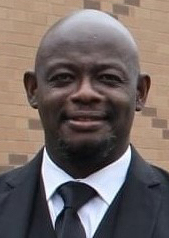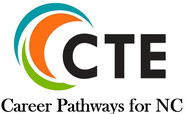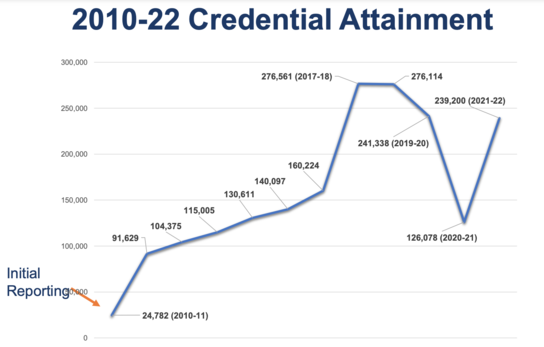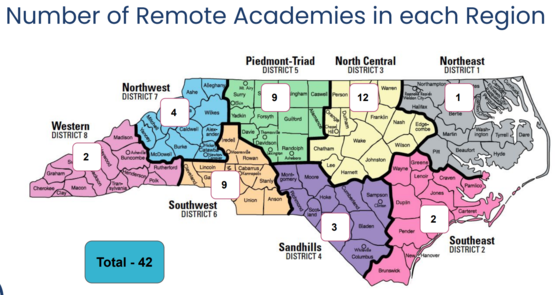
Truitt Outlines Plan for Improved Support to Schools Designated as Low Performing
State Superintendent of Public Instruction Catherine Truitt presented a plan to the State Board of Education this month that she explained is intended to strengthen and better coordinate support services to schools labeled as low performing.
“What I am proposing will mean that rather than taking a scattershot approach to how we support schools that need support, we need to establish a framework that allows us to be intentional, coordinated and well-funded,” Truitt said, “and this support needs to be not done in silos, as it’s occurring now, but it needs to be organized through senior leadership at the Department of Public Instruction.”
|

As a first step, she is adding a newly created position of assistant superintendent of district and school transformation, who will focus on three key functions that touch schools that have been designated low performing: regional directors, Federal Programs and District and School Transformation. Ron Dixon Jr., left, who has been executive director of middle schools for Rowan-Salisbury Schools, will be joining DPI in that role later this month.
Dixon will report to Dr. Jerry Oates, below right, also starting this month, succeeding Dr. Rob Taylor as deputy state superintendent for district and school support services.
|

Often, Truitt said, schools receive multiple visits from DPI staff to provide assistance, but the various supports can be uncoordinated.
“I hear frequently from local superintendents that a school that is designated as low performing [or those with federal designations because of low test scores] might get a coaching visit because they part of the CARES model, then another day that week they might get a visit from someone in Federal Programs, then they might get a third visit in that same week from the Office of Early Learning to talk about their reading plans as required by the Excellent Public Schools Act,” Truitt said. “None of these supports are coordinated.
“This is problematic because when these supports are not coordinated, it becomes a barrier to improvement for that principal and those teachers who are potentially getting different messages from different supports.”
The new leadership structure, she said, is consistent with a recommendation from an outside assessment of DPI’s operations completed during the previous administration that the agency redesign its regional structure to improve services to local districts.
“That is,” Truitt said, “to leverage the people we have in the field already at the agency who are in districts every week doing support work to be more coordinated and more intentional in the way they support schools.”
“We have the regional teams,” she said. “What we don’t have is any kind of reporting structure or accountability system within the agency that will ensure that these teams are coordinated with the specific supports that we give to low performing-designated schools.”
As an additional step, Truitt told the board, she is calling for $10 million in additional funding from the General Assembly for professional development that can be targeted to the specific needs of schools and districts, provided through the NC Center for the Advancement of Teaching, and $2 million for 17 principal coaches to serve 51 low performing-designated schools that are not currently served. She’s also proposing that $4.5 million in unobligated federal COVID-relief funds be used for immediate hiring of principal coaches and for teacher professional development.
Truitt said coaching for principals is crucial for school improvement.
“If the principal is not on board with the transformation that the coach has been brought in to make with the teachers, then that transformation is not going to occur,” said Truitt, who noted that she previously worked three years as a turnaround coach.
“The principal establishes the culture for the building, and we all know that principals are the key lever for retaining high performing teachers.”
|

CTE Credentials Rebound in 2021-22 After COVID-19 Drop, Report to Board Shows
The number of industry-recognized credentials earned by students in North Carolina’s Career and Technical Education courses rebounded during the 2021-22 school year after dropping during the 2020-21 school year because of pandemic-related disruptions, a new report shows.
The recent gains in the numbers of credentials are included in the report, required by the General Assembly and shared this month with the State Board of Education. Nancy Cross, section chief for CTE Reporting and Analysis with DPI, told the board that workforce credentials are becoming more valuable – both for students and employers – as evidence of durable and technical skills.
“Why not leave that to the industries students become employed with?” Cross said. “We know that, according to the U.S. Bureau of Labor Statistics, 46% of civilian workers in 2020-21 were required to have a credential, and our work, in terms of helping to meet that goal, is that 37% of CTE concentrators earned an industry-recognized credential in their pathway of concentration in the 2021-22 school year, an improvement from the 28% the year before.”
|
 |
In all last year, 239,200 credentials were earned by high school students in the state, up from just over 126,000 during the previous year, when the pandemic caused interruptions in many CTE courses. The state had seen a big jump in the number of credentials, to more than 276,00, during the 2017-18 year, Cross explained, because of an accounting change to include “micro credentials” that had been excluded from previous years’ reporting.
As one illustration of credential attainment last year, Cross presented data showing that more than 3,000 students across the state earned a “workplace readiness” credential attesting to their knowledge of such “durable skills” as communication, teamwork, critical thinking, and social skills.
“Those are durable skills that industry partners tell us all the time in CTE that they need,” Cross said. They say: “ ‘We can teach them the technical skills. We need students to know these.’ ”
Cross told the board that CTE programs are also helping the state meet goals set by myFutureNC for postsecondary credentials for attainment while also aligning courses with labor needs identified by the N.C. Workforce Credentials Council. “We offer 70 of the 160 credentials on their list, and students earned credentials in 64 of those 70,” she said, and in all, 41,000 credentials – or 36% of the total number of “combined” credentials earned last year were represented on the council’s list.
In addition to the return to in-person instruction as a key factor in the gain in credential attainment, Cross said, schools also have benefitted from increased funding from the General Assembly to cover the cost of credentialing, $8 million in 2021-22 and reaching $15.8 million for the 2022-23 school year. Local districts were funded over 98% of the needed amount to offer all students the opportunity to earn credentials aligned with their CTE courses.
Districts where students earned the most credentials last year represented those with the largest enrollments: Wake and Union counties, Charlotte-Mecklenburg, Gaston, Cumberland, and Guilford counties as well as smaller districts including those in Caldwell, Randolph, Davidson, and Burke counties.
Districts with the highest credential attainment rates, or the percentage of all potential credentials that were earned by students, were those in Yancey, Burke, Caldwell, Cherokee, Gaston, and Lincoln counties.
CTE teachers receive bonuses based on the number of more advanced credentials that students earned last year. For Tier 2 credentials, teachers are receiving a bonus of $25 per credential, and for Tier 3 credentials, a $50 bonus. Bonus pay per teacher is capped at $3,500.
During 2020-21, students earned 16,817 Tier 2 credentials and 3,573 Tier 3 credentials for a total teacher bonus amount of $586,275 with the $3,500 teacher cap applied. Bonus funding was allotted to PSUs for bonus pay to 1,097 individual teachers.
During 2021-22, students earned 33,300 Tier 2 credentials and 8,215 Tier 3 credentials for a total teacher bonus amount of $1,191,075 with the $3,500 teacher cap applied. Bonus funding was allotted to PSUs for bonus pay to 1,478 individual teachers.
The 2020-21 average bonus received per teacher was $534, a decrease of $173 from the average bonus received per teacher in 2018-19. (The North Carolina General Assembly did not issue any bonus payments during the 2019-20 school year due to reallocation of funds during the onset of COVID-19.) The 2021-22 average bonus received per teachers was $806, an increase of $272 from the average bonus received per teacher in 2020-21.
Board Approves 42 Remote Academies Under New Legislation
The State Board of Education approved the creation of 42 remote academies to open in 2023-24 across North Carolina, operated by local school districts starting this fall. The provision for the virtual schools was included in legislation passed last year by the General Assembly, which directed the State Board to review and approve plans under a set of specific requirements.
The need for widespread remote instruction was an immediate response to the COVID-19 pandemic during the 2020-21 school year, but some families and students have expressed a preference to continue learning remotely even as previously closed schools reopened. Two virtual charter schools have operated in North Carolina prior to the pandemic.
The remote academies approved by the board this month will operate as standalone schools and be subject to accountability rules similar to those that apply to conventional brick-and-mortar schools.
 A list of the 42 remote academies can be found here.
Enrollment in the schools will be voluntary, and instruction will be provided primarily online through a combination of synchronous and asynchronous instruction delivered to students in a remote location outside of the school facility. In addition to meeting the same requirements of conventional schools, the remote academies are also required to provide any needed hardware and software for students at no cost (except for any damage or abuse), access to a learning management platform that enables monitoring of student performance and school-owned devices, as well as allows video conferencing and supervised text-based chat for synchronous communication, as well as technical support during the school day.
The schools must also make provisions for special education students, including adaptive or assistive devices, transportation, and in-person services as required by that program or plan.
In applying for approval of the remote academies, school districts were required to provide details about the proposed schools, including the range of grades for which the remote academy will offer courses, the measures used to ensure that both synchronous and asynchronous remote instruction time, practice, and application components support mastery of course content, and characteristics for successful remote learning and criteria for admission to the remote academy.
Total enrollment in the 42 remote academies is projected at about 12,000 students for the 2023-24 school year.
Report Details Progress of NC’s Dual Enrollment Programs
North Carolina remains a national leader in dual enrollment programs that allow high school students to simultaneously take college classes, according to a report to the General Assembly presented this month to the State Board.
“North Carolina’s Career and College Promise (CCP) Program has been recognized as a model dual enrollment program and as a model for dual enrollment policy by the Education Commission of the States,” the report says. “Additionally, NC is a leader in the nation in the number of established Cooperative Innovative High Schools (CIHS).
“The strength of collaborative partnerships between high schools and colleges, statewide articulation agreements, the requirement for structured pathways, student eligibility criteria, state-level agency collaboration and state-wide policy and funding are what make NC’s Career and College Promise Program a model for other states.”
The annual report, which includes information about both the state’s Career and College Promise program (CCP) and early college high schools (or Cooperative Innovative High Schools), details enrollment trends and rates of success by students in earning college credit.
In presenting the report, Sneha Shah-Coltrane, director of DPI’s Office of Advanced Learning and Gifted Education, told the board that participation in CCP is rebounding from the COVID-19 pandemic, when numbers dipped.
“We’ve almost recovered our pandemic drop in enrollment,” Shah-Coltrane said, with about 2,000 students fewer participating. In all, about 32,300 students enrolled in at least one dual-enrollment course. Among graduates last year, 32% of them took at least one dual-enrollment course, and the average was seven courses during their high school years, accounting for a total 229,353 courses in all.
 
Data on the state’s Cooperative Innovative High Schools, or early college high schools, shows that during the 2021-22 school year:
- 28,465 were enrolled in 133 schools statewide, 428 fewer than the year before (pandemic related).
- 6,243 graduated, 110 fewer than the year before.
- 3,200 earned associate degrees in addition to their high school diplomas.
- 1,184 individual students earned 3,365 industry-recognized credentials through high school CTE courses.
- CIHS students also earned a total of 1,047 diploma and certificate credentials, based on community college system data, representing a total of 2,231 individual credentials earned from both community colleges and the high schools, an increase of 515 credentials from the previous school year.
The board also heard from a recent graduate of Gaston (County) Early College and a current 5th year senior at Early College EAST in Craven County, who connected remotely, both of whom spoke of the strengths of early colleges.
Allen Chen, now a student at MIT, said that Gaston Early College gave him the opportunity to take rigorous and advanced courses while also teaching him life lessons through the school’s efforts to forge close connections with the community and the school’s family like culture.
“GC has a lot of supportive teachers,” Allen told board members, “and it helped me realize my passion for helping in my community.”
Josh Hardison, who’s now working on his associate degree as a “super senior” at Early College EAST, said that despite a learning disability, the school persuaded him that he could succeed in honors-level classes required at the school and that support was available.
“I’ve gone through support classes, after-school tutoring and weekly check-ins throughout my high school,” Josh said, “and now that I’m in college taking college classes, I still have weekly check-ins, and if I need more help, I find out where to go for that help.”
|